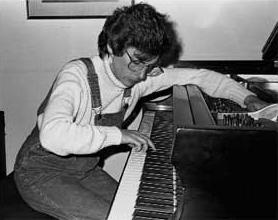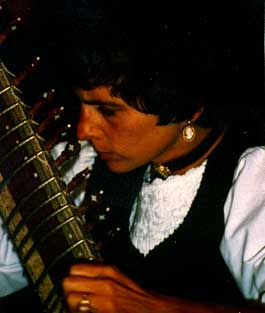Praise for Sarah Meneely-Kyder
|
Read Neely Bruce’s review of the oratorio Sarah Meneely-Kyder’s A Garland of Hymns and Carols owes its origins to the composer’s charming custom of appending miniature scores of her Christmas music – and in some cases, her poetry – to greeting cards intended for family and friends. Illustrated by her husband, artist Wayne Kyder, these cards became a family tradition that has, so far, endured for twenty-seven years. Realizing that she had accumulated a substantial body of work, and wishing to emphasize to her family that, yes, this was “real” music, she decided to record the complete series. Real this music most certainly is, and beautiful, as well. Understandably, many of these hymns and carols were inspired by Renaissance, Baroque, and Medieval models, as those are the eras perhaps most firmly imprinted in the collective consciousness as founts of Christmas music. Meneely-Kyder has obviously absorbed these style’s salient features, showing, for example, a flair for polyphonic writing in her Renaissance-like pieces. She has a keen ear for instrumental color – the bells that lend a medieval air to It is Thou, and the floating harp in the ethereal Song of Mary are but two memorable examples. I’d also like to mention the flowing piano accompaniment to How Softly Breathes Your Little Child, a lovely duet for female voices, that recalls Bach’s “Jesu, Joy of Man’s Desiring”. Meneely-Kyder doesn’t shy away from modernism, using seconds in one carol and freely employing atonality in others. These “advanced” techniques are handled lyrically and don’t disrupt the set’s musical or emotional coherence with violent discord or melodic angularity. In addition, she’s fond of modes, some of her own creation, and wrote at least one piece influenced by Arvo Pärt’s brand of “spiritual minimalism.” In mood the collection encompasses contemplative repose and jubilant celebration, alternating among solo voice or duets, a capella choir, and chorus plus instruments. The recording’s pleasing but not excessive reverberation flatters the music without blurring the lines, and the instrumental and vocal timbres are realistically captured. The choir is smooth and well balanced and the solo singers’ and instrumentalists’ contributions are first rate. Be sure to listen to the bonus selection, a second version of Dona Nobis Pacem (not listed in the contents and played about five minutes after the apparent end of the CD). The two frame the collection and give Meneely-Kyder an opportunity to illustrate the same text in widely divergent styles. This is an enhanced CD, allowing buyers to view the cards in detail on their computer screens (they’re also prettily arranged on the booklet’s cover). A Garland of Hymns and Carols is a talented composer’s heartfelt gift to the world and a worthy addition to the genre. —Robert Schulslaper, “Intuitive Measures”, Fanfare Nov./Dec. 2009 A Garland of Hymns and Carols is available at CD Baby and both Letter from Italy and Weep, the Might Typhoons are listed at ArkivMusic Another highlight comes with Sarah Meneely-Kyder’s Letter from Italy, 1944. The Walt Whitman-ish text is by the composer’s sister, who assembled it from their father’s wartime letters and diary entries. The setting is a sensitive one, as befits the subject, and it is gorgeously sung by baritone Chai-lun Yueh. Trenchantly dramatic, eerie, frightening and warmly lyrical as the text requires, Meneely-Kyder’s music goes beneath the surface and explores the complex emotions of the poem’s narrator … —Raymond Tuttle, Fanfare July/August 2003 The inexplicable essence that defines American music is pondered on the North/South Recordings new release Millennium Overture. Compositions by Allan Crossman and Sarah Meneely-Kyder round out this wide ranging collection of American music —NewMusicBox, American Music Center, February 2003 |
Regarding Weep, The Mighty Typhoons … The work itself is simply gorgeous. Meneely-Kyder is a brilliant exponent of her own very resourceful keyboard writing, which combines an essentially consonant harmonic language with many extended performance techniques used in the coloristic manner often associated with George Crumb. —John Story – Fanfare, March/April 1998 The entire program was a feast for the soul. The intensely personal nature of Meneely-Kyder’s work and the wide-ranging spiritual messages she has to deliver add to her already established reputation as one of our finest contemporary composers. —Susan Hulsman Bingham, 1989 
Weep, The Mighty Typhoons, by Ms. Kyder is a work of great eerie power. The audacious structure was built by merging haiku in a cycle of seasons with poems by survivors of Nagasaki and Hiroshima, as adapted by the composer … A lost child was invoked as a related theme. This text was developed with the soprano, Laura Cook, who commissioned the work … Ms. Meneely-Kyder, who performed the piano part, attempted precise remarkable effects, as of Oriental instruments, by reaching inside the piano to pluck or damp the strings in combination with playing on the keyboard. —Michael Smith, New London Day, 1984 Almost as surprising were works from the ’50s … while an Arioso and Allegro from 1955 (beautifully played by pianist Sarah Meneely-Kyder) was pastoral in an early-Wolpe vein, with a Coplandy climax; it deserves to become a minor classic of American keyboard repertoire —Kyle Gann, Village Voice Truly touching was I Have Lighted The Candles, Mary by Sarah Meneely-Kyder … a split-level tableau … that could have fallen into many traps but didn’t.… Various technical tricks were tried out – chance, microtone, ‘on-the-string’ pianism … unvocalized declamation – but there was also a radiance that brought to mind Stravinsky’s Petrushka as much as Schoenberg’s Pierrot Lunaire. —Danbury Times, 1981 
One work was by a young woman, Sarah Meneely, who was just finishing her senior year at Goucher when her 3 Movements for Piano and Orchestra was played. She may well turn out to be a genuinely great composer … Sarah Meneely is in a class by herself, if only because she is not yet out of classes. 3 Movements for Piano and Orchestra, at least parts of which are serialized, is her third composition, and, though it is hard to believe after hearing some of her brilliantly original textures, her first orchestral work … This is a good piece by any standards and without any allowances for its composer’s inexperience. Clearly, hers is a name to remember. —Donald Mintz, Washington Post, 1967 |
| Contact: e-mail Sarah Meneely-Kyder | © 2004–2014 Sarah Meneely-Kyder |
